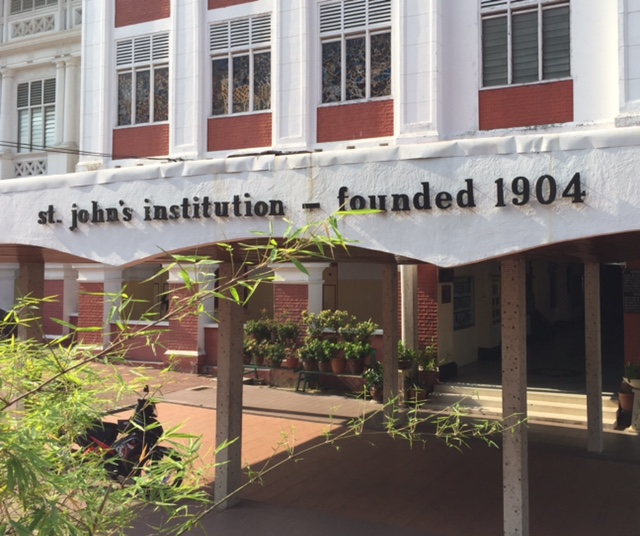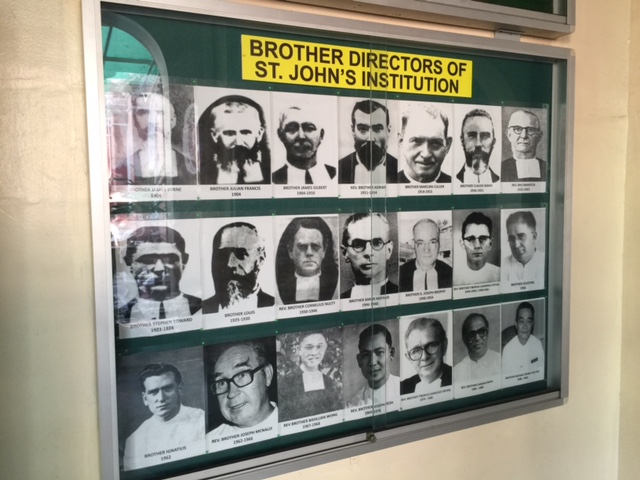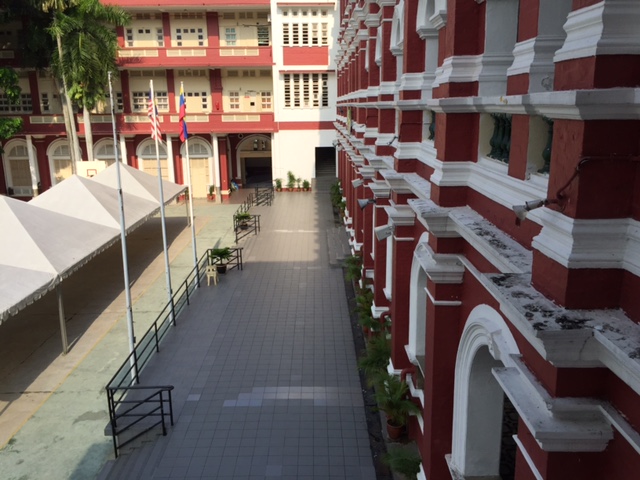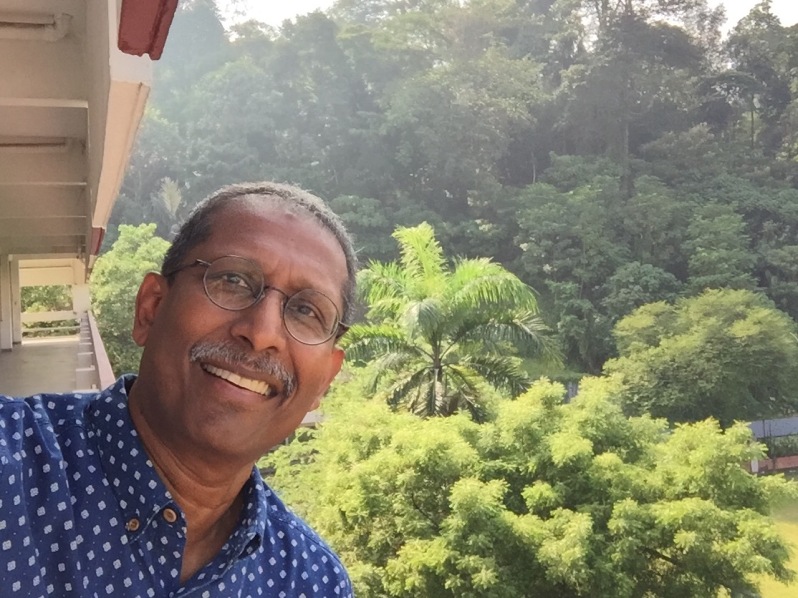
The Monday morning I wandered into St John’s Institution in Kuala Lumpur, nobody stopped me. I didn’t see the sign asking visitors to report to the office until I was leaving an hour later. Somehow it didn’t feel like I needed permission to be here because I knew this place too well. I also knew that sound coming out of the red-bricked building that is my old school. Teenage boys’ voices, shout-talking, laughing, hooting, the tomfoolery erupting the moment the teacher stepped out of the classroom. Sometimes with the teacher still there.
Entering the portico I wonder which school has a portico, for heaven’s sake? We learnt the word from that Irishman Joseph McNally, the Christian Brother who was our principal and appeared at Speech Day and official occasions wearing his graduate’s gown over his religious habit, who spoke directly to us like we were human beings. He was a headmaster possessed by many dreams of making St John’s better than it already was. He spoke of the fine work of his predecessors, another word I learnt from him. We had to build on all that they had left behind, he’d say, and he wanted us to have new college-style lecture theatres, a gymnasium and a Sixth Form block with airy, well-lit classrooms. He had a team of powerful supporters and all the projects he talked about at school assemblies became reality right before our eyes in the years we were in school. He also left his successor an enormous debt to deal with, but that’s a detail.


Brother Joseph McNally was also an artist and he wanted this magnificent school founded in 1904 to have a portico. The main block already boasted an impressive red-brick and white-arched façade. But he felt it deserved a more imposing entrance – a new porch for cars to drive up to, and then a grand covered walkway that would lead to the classroom block and assembly area on the right, or up the staircase to the principal’s office, more classrooms, the brothers’ quarters and the chapel. It would have a beautiful terrazzo floor, for which art teacher Oon Mow Sheik would design stylised mosaics of the school’s crest – the Golden Eagle of St John the Evangelist – and the emblems of the five sports houses. As Brother Joseph talked about all his projects he would tell us about his portico. And one day, there it was. In 1967 St John’s must have had the grandest entrance of any school in all of Malaysia. He was principal for five years and moved on to Singapore where he became principal of St Patrick’s School and later founded the La Salle College of the Arts. By the time he died in 2002, he was renowned not only as an extraordinary educator but also as an artist and sculptor.
Art teacher Oon Mow Sheik’s mosaics of the school crest and, clockwise from top right, the emblems of the Claude, Cornelius, Stephen, Gilbert and D. Joseph sports houses.
Now it’s August 1, 2016. I enter my old school through Brother Joseph McNally’s portico and it is mostly as it was half a century ago. They’ve added a row of showcases on one side, and surely that man who possessed such style and a desire for Doing It Better would have thought them somewhat shabby. The first bears the photographs and names of prominent past students. It is remarkable how, for a Catholic boys’ school 112 years old, almost all the prominent old boys on display are Malays and Muslims. Somebody did a good job of forgetting. But I almost forgive that when I see another showcase with familiar portraits of every Brother Director from Brother James Byrne in 1904 to Brother Michael Wong in 2002. These faces – in turn stern, bespectacled, bearded, kindly and mostly European – appeared regularly in school publications for special anniversaries. The principals when I was in secondary school, from 1966 to 1972, were Brother Joseph McNally, Brother Basilian Wong and Brother Joseph Yeoh, each man a larger-than-life character. Brother Basilian succeeded Brother Joseph McNally and was the first Asian principal of St John’s. He stayed two years, raised funds like a madman to clear a mountain of debt, then left and, we heard later, left the religious life as well.

Brother Joseph Yeoh, principal during my last four years at school, arrived in 1969 and stayed a decade. A fierce disciplinarian who strode the corridors with a cane in one hand, he would enter a noisy class, thwack a table hard and demand to know who was the class monitor who should have been keeping the peace. He wielded his cane at Monday assemblies, rounded up long-haired boys for on-the-spot haircuts, and gave smokers hell. He also proved an extraordinary champion of sports, although he used his assemblies to celebrate every achievement by a student in any extra-curricular activity no matter how unglamourous. The year he arrived as principal, Kuala Lumpur and Malaysia were traumatised by race riots and he had to deal with the fallout that would have a profound impact on our school.
Throughout my schooldays, St John’s attracted Catholics and boys from Malaysia’s capital city, and that meant my schoolmates were multi-racial but mostly Chinese, reflecting Kuala Lumpur’s make-up at the time. Writing in the school’s 60th anniversary souvenir magazine in 1964, one of its firmest supporters, pioneer cabinet minister Dr Ismail Abdul Rahman, noted that in the student body, “500 Malays mingle with 1,000 Chinese and Indians; these receive their education from a staff a third of whom are Chinese, more than a third Indian, and the rest Malay, Eurasian and European. I congratulate St John’s on being such a nursery of inter-racial harmony”. We took that state of harmony as just the way things were in our school.

Much changed in the wake of the May 13, 1969 race riots and the country’s new emphasis on improving the economic lot of the indigenous Malays. One change had a dramatic effect on my Class of 1970 and nobody saw it coming. Our year was the first when the national language, Bahasa Malaysia, was made compulsory to secure a pass in the Malaysian Certificate of Education (MCE) examinations – the O levels equivalent. St John’s had regularly secured a pass rate of above 80 per cent in the national examinations. Doing well allowed you to proceed to Sixth Form and there was never a problem filling the available places with St John’s boys. Until my year. There were 322 of us who sat the MCE in 1970 and almost four out of five failed Bahasa Malaysia and therefore failed the whole examination. Only 89 passed Bahasa Malaysia, making for a withering pass rate of 22 per cent. If not for the new rule, the Class of 1970 would have scored 85 per cent passes.
There was no explaining how barely one in five, myself included, passed. Too many of the best boys failed the MCE despite obtaining several distinctions in other subjects, and had to leave St John’s bewildered and bitterly disappointed. They could repeat the examination, start working or leave Malaysia to continue their education overseas if their parents could afford it. Several went to Australia or Britain. Some star students moved to Singapore, and their excellent results in everything other than Bahasa Malaysia let them enter junior college, ace the A levels and proceed to university. That culling of the cream of the 1970 crop remains a part of the SJI story not told adequately, though my classmates still talk about the year we sat our examinations blissfully unaware that we were participating in a Pass or Fail lottery.

I got to stay two more years and finish Sixth Form at St John’s. One other thing Brother Joseph Yeoh did as principal was to allow the student body to elect the head prefect, whom we called the School Captain. Up until then, the head boy had been appointed by the teachers and it was often a prefect with outstanding achievements in academics, sports or extra-curricular activities. The tragic outcome of our Fifth Form examinations robbed my year of some candidates for head boy. But a clutch of us were still there and we made up the field. I emerged the unlikely winner, the furthest anyone could get from being a sports hero and not the guy expected to shine at the next exam. But as head boy I had to deal with Brother Joseph Yeoh up close, and it took me many years to realise what an exceptional leader he was for St John’s, which was his old school too. It took me longer to appreciate that the election he introduced and my winning provided me a first experience of audacity to survive doing the unlikely thing. It was a lesson for life though I didn’t realise it at the time.

In all, I spent 14 years on Bukit Nanas – seven years in secondary school, six at St John’s Primary School One across the road, and a year at Fatima Kindergarten, which occupied the original premises of the old St John’s Church before the cathedral became the landmark at the foot of the hill. Some of my school friends go all the way back to 1959 when we started in kindergarten. From there we crossed the road to the two-session primary school. After Standard Six, all the boys from St John’s Primary School One and School Two moved to the big secondary school further up Bukit Nanas to become the Form One cohort – 10 classes of 35 to 40 boys.

Bukit Nanas – which means “Pineapple Hill” – was and remains the physical heart of the Catholic Church in Malaysia. Aside from the cathedral, priest’s house, the old church and the boys’ schools, there is also the Bukit Nanas Convent founded by the Infant Jesus order of Catholic nuns, and the Archbishop’s house at the edge of the forested hilltop. Going to school on Bukit Nanas in the 1960s meant there were always lots of girls and boys trudging up and down every day, the convent girls in their box-pleated blue pinafores keeping to the left side of the street, while the SJI boys in all-whites stayed on the right. St John’s also took in girls at Sixth Form, and they stood out in their white blouses and SJI-green skirts. Being a kid on that hill meant having all sorts of aspirations to cross the street for one reason or other.
I left St John’s in 1972 and stayed away a long time. I returned for the 100th anniversary celebration in 2004 but it left me feeling too much an outsider and by that time I had changed country as well. This time, I return alone as an old boy in his 60s. I go through Brother Joseph McNally’s portico and up the stairs to the main block and walk along the corridors where my classrooms had been. I cross over to the Sixth Form block and go up to the top floor classroom where Miss Rosa Chang had her hissy fits as she returned our essays and swore we were the worst English Literature students she had ever seen. I head down to the cafeteria and it’s recess time. There’s this swarm of boys talking at the top of their voices and diving at the foodstalls, all run by Muslim women in headscarves. It smells so different. But I shut my eyes and for a moment, I am a schoolboy too. And this is where I come from.










Wonderful recollection!! It’s a long time since we both left SJI, but still feel a warm attachment to the old alma mater, despite the changes over the years. Being a teacher now, gives me the insight of how great some of our former teachers were, and how much those days meant in our formation as adults. Certainly one realisation of the dream of the great educator, St John Baptist de La Salle!!
LikeLike
AJ ..I didn’t know until now of the statistics you mentioned ..that only 82 out of 322 of our cohort in SJI who sat for the 1970 MCE exam was given a pass in Bahasa Malaysia.
What a shame! What a waste! What a loss !
LikeLike
Beautifully put together and very much appreciated. I was there and after Form Three in 1960 I completed my studies at Aquinas College in Perth, Western Australia. My memories of St John’s were happy ones. Brother Lawrence was the Brother-Director then and the teachers were dedicated (strict but with a good sense of humour). I’ve lost touch with many of my peers but would love to catch up with any one of them. All the very best. Peter de Souza, Canberra.
LikeLike
Are you the James Peter that was in my class in Form 2 ,1959? I’m Dominic Michael and I live in Italy now. If it’s you, I’d love to hear from you!!
LikeLike
I was there from Standard 1 (Headmaster Arokiasamy) thru Form 5 Bro.Joseph Yeoh). Good old memories. Remember the cannings for getting into a fight. Not my fault tho. If u remember Charlie, our fearless Trumpeter who leads us at every Sports games. My finest n proudest moment was coming home from Penang after WINNING the Boy’s Badminton Kings Cup… 1973 I believe. Many more to share with all Johannians out there. I live in the great States of Florida n ready for retirement. Hopefully, Planning to visit families in KL n Singapore. Cheers, mate….
LikeLike
Charlie here, Trumpeter, Kings Cup winning trip to Penang {1972} with the School bus, Noel Cheow and all. School Captain 1962 – dear Alan John, sums it all up very nicely. AJ was Editor of NST, S’pore. Cheer2 & Courage displayed by All the Saints whom have given their best n gone marching in.
LikeLike
Dear Charles, thanks for reading and writing to me, much appreciated. I left The Straits Times, Singapore, as deputy editor. Best regards, Alan.
LikeLike
I was proud and honoured to have been an HSC student at St Johns in 1960 -61 when Bro Lawrence was Director, after completing Form 5 at The Convent, Klang. A really wonderful experience in a co-ed school with strict disciplinarian teachers like Mrs Michael, Mrs Wang, Bro Damien etc. I’m now living in Australia but last year, when I visited KL, I made it point to take a walk up Bukit Nanas with my OZ friend, Dianne, to show her the iconic St Johns Institution, my former school! My 3 brothers and my son were also past students of St Johns!
LikeLike
Dear Beatrice, thanks for sharing that memory, and for reading this. Best regards, Alan
LikeLike